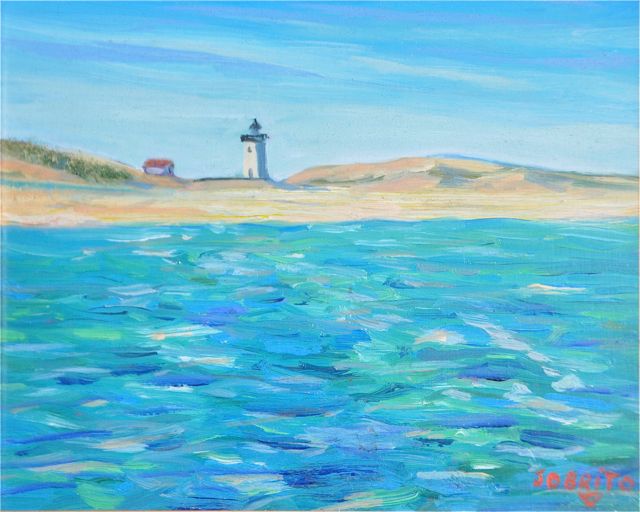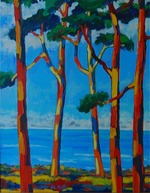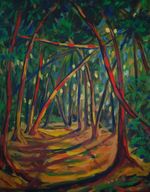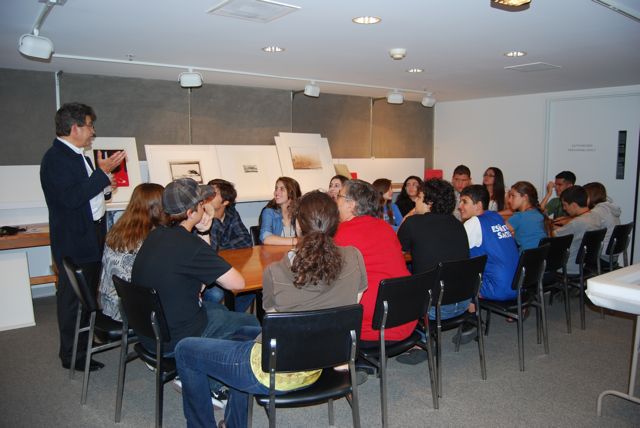
Provincetown Magazine by: Jeannette de Beauvoir
The colors are vibrant and bright, bright as the sunlight in João de Brito’s native Portugal and just as welcoming. They belong to paintings that comprise scenes from the artist’s homeland, scenes from his travels in Europe, scenes from here on the Outer Cape, that form a distinctive way of looking at what de Brito calls the “discovery of the everyday.”
You can see some of these paintings at Thanassi Gallery during this year’s Provincetown Portuguese Festival, as part of a special exhibit of João de Brito’s work in oils and giclée, titled Coastal Views.
De Brito is no stranger to Provincetown. A longtime member of the venerable Beachcomber’s Club—and the first Azorean visual artist invited to join—he has a long history with the town. “I was offered a stay in Harry Kemp’s shack,” he says. “I was not able to stay for any length of time, but I spent several hours there. His poetry moved me incredibly... it’s a special world out in the dunes.” (Included in the exhibit at the Thanassi Gallery is a painting of the Tasha and Margo Gelb dune shacks.)
The names he cites as friends are icons of Provincetown, past and present. “I did a painting of Flyer Santos, and this fellow from Toronto fell in love with it and bought it right away,” he remembers. “Napi showed me his collection, and looking at all those paintings—it is like taking a journey. There’s a special energy here, especially in the winter. “Provincetown reminds me of the Azores,” de Brito continues. “It’s flooded with light, with that ocean reflection … I think that I paint things even brighter than they are in reality, because I want to put a positive spin on my art. On a bad day, I want to sit in front of a painting with a cup of tea or a couple of glasses of wine, and if it makes me feel better, it’s done its job.”
Certainly his own paintings do that. Described as exotic, magical, and surreal, they invite the viewer to participate in the sheer exuberance of de Brito’s vision. The Thanassi Gallery exhibit includes a number of paintings—especially those of the Outer Cape, as well as one of Tuscany—that are so filled with light, life, and joy that the viewer cannot help but smile when looking at them. “I like my work to be pleasing,” admits de Brito. “But beyond that pleasure, you can go deeper. There are layers of paint, layers of me... you’ll never get bored. I put the wrong colors in the right places purposely, to draw people in. That’s the essential aspect of the creative spirit. It’s true to who I am as a person.”
João de Brito was born on a small island an ocean away from Cape Cod, in a creative and artistic milieu in the Azores archipelago that was “very much like Provincetown,” according to the artist. He emigrated from Portugal with his family when he was a teenager and lived in Massachusetts and Rhode Island before moving to California—with its own coastal beauty and light—where he continues to live and from which he departs frequently to travel and paint en plein air. “I moved there to study,” the artist explains. “And stayed.”
His studies and influences are wide. Working and learning both in the United States and in Europe, he looked constantly for ways to convey the brightness of his vision. The French fauves, the early California impressionists, the Society of Six, Selden Gile and August Gay, Armin Hansen, the late Nathan Oliveira and E. Charlton Fortune, and Portuguese artists Domingo Rebelo and Viera da Silva all played a part in de Brito’s developing style. But “it is a distinctive style now,” says Vasso Trellis, curator of the exhibit at the Thanassi Gallery. “The colors and the lines are distinctive, the use of light, these are all his style.”
De Brito may travel widely for his plein-air paintings, but he returns again and again to his native Portugal … and to Provincetown. He is drawn to scenes that use vivid colors to convey—and create—an underlying powerful emotion, something a reviewer cited as “reaching out to the viewer’s soul.” He finds those colors in Azorean island images and also here on the Cape. “In my work,” he explains, “I seek to incorporate an understanding of the topography, sea, and people of Cape Cod. I try to [provoke] the viewers on a visceral level to enjoy my paintings now and in the future.”
João de Brito has collaborated with a number of other artists, among them impressionists William B. Hannum and Mark Geller and traditional painter David Leffel. It’s a different sort of collaboration that is absorbing him at the moment, however. “I’m involved in several exciting projects right now,” he responds when asked when he’ll next be in Provincetown, “so I’m debating what to do. I was contacted by a professor of music in Texas who saw my art and wanted to put it to music. So far the collaboration includes four piano solos, but there’s an entire symphony in the works and we’re getting a crew together to record it. The Berkeley Symphony wants to take it on the road!”
It’s certainly a collaboration to look forward to. In the meantime, the collection at the Thanassi Gallery will give viewers a vivid taste of João de Brito’s art: a celebration of life, and an enduring vision of a brighter world.
“Coastal Views: The Art of João de Brito” is on exhibit June 23 - July 1 at Thanassi Gallery, 234 Commercial St., Provincetown, 508.487.0233. There will be an opening reception on Saturday, June 25th, 7 - 9 p.m.
http://provincetownmagazine.org/Art/the-exuberant-images-of-joao-de-brito
 João de Brito paintings will be featured at Center Street Grill again, Joao was born on a small island in the middle of the Atlantic Ocean and after living in New England for ten years, he moved to California in 1978. The natural colors and reflection of the sun from the Ocean reminded him of his homeland and gave him comfort.
João de Brito paintings will be featured at Center Street Grill again, Joao was born on a small island in the middle of the Atlantic Ocean and after living in New England for ten years, he moved to California in 1978. The natural colors and reflection of the sun from the Ocean reminded him of his homeland and gave him comfort. Tuesday, November 29, 2011 at 11:30PM
Tuesday, November 29, 2011 at 11:30PM


